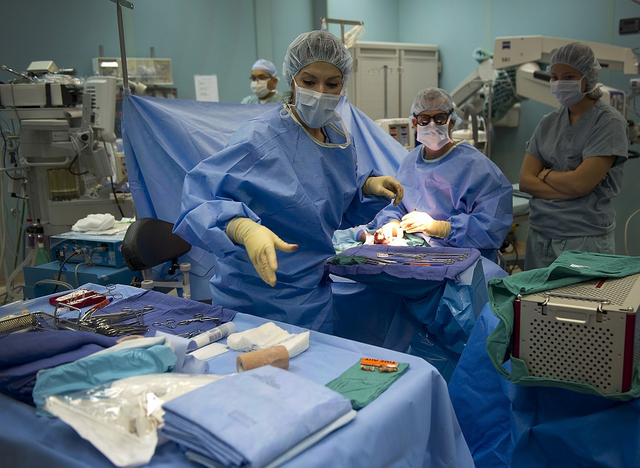Curating the Internet: Science and technology micro-summaries for August 18, 2019
A gel for sealing internal wounds can be made from the body's own bacteria; A Steem review of an article in July's issue of Science: T cell–mediated regulation of the microbiota protects against obesity; IEEE Spectrum's weekly selection of awesome robot videos; Approaching the paranormal from a scientific perspective; Cool but obscure tools for the X11 windows system
Straight from my RSS feed | Whatever gets my attention |
Links and micro-summaries from my 1000+ daily headlines. I filter them so you don't have to.
- Scientists create gut gel 'band-aid' made from the body's own bacteria - A problem for treating wounds to the gut or intestine is that patches and bandages won't stick to the slippery walls of the enclosure. To address this problem, a team of scientists from Harvard has created a hydrogel from the body's own bacteria that can be applied through syringes or sprays. The consistency of the gel is similar to the mucus that occurs naturally in the body, and it can be tailored for particular areas of the body. Postdoctoral fellow, and research team member, Anna Duraj-Thatte, describes the method as a hack of the natural healing process of the human body. To date, the process has only been tried on animals, so it may be a while before it shows up in operating rooms.
- STEEM The miscommunication between T cells and microbiome makes the poor mice fat - Journal club - In this post, @scienceblocks discusses
T cell–mediated regulation of the microbiota protects against obesity published by Petersen et al from June Round's and W. Zac Stephens' labs at Utah. It is published (in the) july 2019 edition of Science.
The post reports that, by editing the genome to effect the immune system's T cells and conducting experiments, researchers were able to determine that certain bacteria in mice effect weight gain. In fact, mice that are treated with antibiotics and then exposed to bacteria from the guts of obese humans become obese, whereas bacteria that are treated with antibiotics and exposed to bacteria from the guts of lean humans do not. Additionally, the post notes that scientists were able to spread the bacteria for obesity by housing the mice together, implying that obesity in mice actually is contagious (which reminds me of a viral news story from just over a decade ago). In addition to summarizing the paper, @scienceblocks also expresses the frustration that it left many loose ends, creating as many new questions as it answered. (A 10% beneficiary setting has been applied to this post for @scienceblocks.) - Video Friday: Watch Robots Make a Crepe and Twist the Perfect Pretzel - This week, IEEE Spectrum's weekly selection of awesome robot videos includes: A diverse squad of robots from Team CoSTAR (JPL, MIT, Caltech, KAIST, LTU); Ground and aerial robots from Carnegie Mellon and Oregon State University for the DARPA Subterranean Challenge; quadrupeds that can carry you around in a chair, play tug-of-war; tow a minivan; or navigate a maze; a pharmaceutical assembly robot that can produce personalized tablets with medicine for multiple ailments; a dogs' head on a quadruped robot; Competing with wheel chairs, arm and leg prosthetic robots; and more...
Here's my favorite, with robotic wheat harvesting:
In order to help make Steem the go to place for timely information on diverse topics, I invite you to discuss any of these links in the comments and/or your own response post.
My other open posts
@remlaps
@remlaps-lite
- Curating the Internet: Science and technology micro-summaries
for August 17, 2019
- Curating the Internet: Science and technology micro-summarie
s for August 16, 2019
- Curating the Internet: Science and technology micro-summaries
for August 15, 2019
- Curating the Internet: Science and technology micro-summaries
for August 14, 2019
- Curating the Internet: Science and technology micro-sum
maries for August 13, 2019
- Curating the Internet: Science and technology micro-sum
maries for August 12, 2019
About this series
Like what you read? I'd like to cover more links and topics, but the research is time consuming. Your upvotes and shares will help me to expand this series and to share more collaboration rewards with other Steem authors.
Note: Sharing a link does not imply endorsement or agreement, and I receive no incentives for sharing from any of the content producers.
Follow on steem: @remlaps-lite, @remlaps
If you are not on Steem yet, you can follow through RSS: remlaps-lite, remlaps.
Thanks to SteemRSS from philipkoon, doriitamar, and torrey.blog for the Steem RSS feeds!

Wow, thanks for mentioning and summarizing my post. Also, really liked the link of decade old study you added. I am going to look at it in detail. It sure as hell looks interesting. Once again thanks for reading, sharing and supporting my work. 🙂
Posted using Partiko Android
You're welcome. And thanks for the interesting article. I have been thinking for a while that there must be some sort of probiotic treatment that would reduce/prevent obesity by cultivating the "right" microbiome, so I think this topic was very interesting, and I'm glad you brought it to my attention.
Really intresting blog bro.